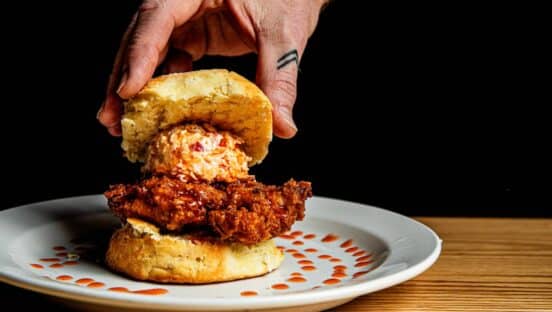One moment of clarity changed everything for the cofounder of Tender Greens, the Los Angeles–based Fast Casual 2.0 chain whose motto is “Slow food done fast.”
It was 25 years ago, and Erik Oberholtzer, then a cook just out of culinary school, found himself working in the already-legendary kitchens of Chez Panisse, the Berkeley, California, farm-to-table restaurant owned by celebrity chef Alice Waters. Everything—yes, everything—that was served that night arrived fresh and local that day.
“It blew my mind,” Oberholtzer recalls. “Everything was so fresh. You’d step into the restaurant’s kitchen and you would see everything that arrived that morning.”
Fast forward to 2006. That’s when Oberholtzer and his business partners, Matt Lyman and David Dressler, were writing a business plan for Tender Greens. Everything seemed to circle back to his days at Chez Panisse. “Our mission statement for Tender Greens was this: What if Alice Waters were to open a fast-food restaurant? What would it be?” Oberholtzer says. “That has informed every product decision since.”
Today, Tender Greens has 22 California locations and is attempting to impact the way the fast-casual restaurant world views where its food comes from. At a time when the growth of fast-casual dining is taking off at hyperspeed, Tender Greens and upscale brands are promoting a separate trend right along with it: hyperlocal sourcing. That is, modestly priced restaurants that grow much of their own food, often near or even on the premises.
“Authentic storytelling is vital to any brand,” says Harry Hawk, a hospitality industry consultant. “Stories about food and who grew it and where it was grown—and how it’s going to make it to the table—are great stories to tell.”
Most of Tender Greens’ produce comes fresh-picked daily from Oxnard, California’s Scarborough Farms, an investor in the fast casual. But Tender Greens curates other relationships with small farmers in each of the markets where it operates. In San Diego, for example, there’s a farm in the Point Loma area from which the restaurant has purchased produce for nearly a decade. “Our chefs might walk up the hill in the morning, see what’s being harvested, and that might inspire our specials for the day,” Oberholtzer says. At one point, that farm was a half mile from the restaurant; today, because of growth, the farm is about 30 miles from the restaurant. The farm supplies the restaurant everything from citrus to avocados, he says.
Then there’s the stuff Tender Greens grows right on premise. At the Mission Valley, California, location, about five minutes from downtown San Diego, there are 16 aeroponic towers, each about 8 feet tall, that use a combination of air and mist to grow produce for the restaurant. These towers grow everything from herbs to cilantro, spinach, and butter lettuce.
“How cool is that, to walk into a restaurant where you see a tower growing the food that you’re going to eat?” Oberholtzer says. “We’ve gone through decades of being unconnected to food. This reconnects people to the romance of food and the reality of where it comes from.”
Similarly, at Tender Greens’ Hollywood location, it has two aeroponic and hydroponic towers (the latter leverages water and minerals) that are home to 600 plants at any time. “We harvest them once a week and use them in restaurant specials,” he says.
Meanwhile, the restaurant in Irvine, California, is less than two miles from the farm that supplies much of its produce. “A farmer will harvest the crop, and 30 minutes later it’s in our kitchen—and 30 minutes after that, it’s on someone’s plate for lunch,” Oberholtzer says.
The hyperlocal sourcing won’t stop at the California border. Tender Greens has plans for locations on the East Coast, and Oberholtzer says systems like aeroponic and hydroponic towers will help the concept stick to its core values as it grows. “We’re going through a second food revolution,” he says. The first, he says, was the organic food movement started 35 years ago by Waters. The second is “the democratization of hyperlocal.”
Tender Greens is far from the only multiunit restaurant concept to take notice of hyperlocal sourcing. On the National Restaurant Association’s “What’s Hot” culinary forecast for 2016, hyperlocal sourcing landed at No. 4 on the list of top trends for the year.
John Mooney is chef and co-owner of Bell Book & Candle, a six-year-old restaurant in New York City’s West Village that grows much of its own produce on the roof. By growing produce himself, he doesn’t even have to rely on his relationships with farmers. About two years ago, Mooney opened another hyperlocal restaurant, Bidwell, in D.C.’s Union Market. Some of that produce, from zucchini to melons and berries to chili peppers, is grown right in front of the restaurant and on its rooftop. There’s even a fig tree out front.
Mooney wants to see the hyperlocal eating scene extend into fast casual. He’s in a partnership with another D.C.-area restaurant, Hälsa, that’s focused on sustainable, fast-casual dining. And many others are coming to him to learn. “I get inquiries from all over the world,” Mooney says. His advice to those who truly want to create a hyperlocal menu can be summed up in one word: patience. It’s part art. It’s part science. And it’s part TLC. It will likely require at least two seasons for the restaurant to get any return on the investment, he says. But in the long run, he adds, “It saves money.”=




